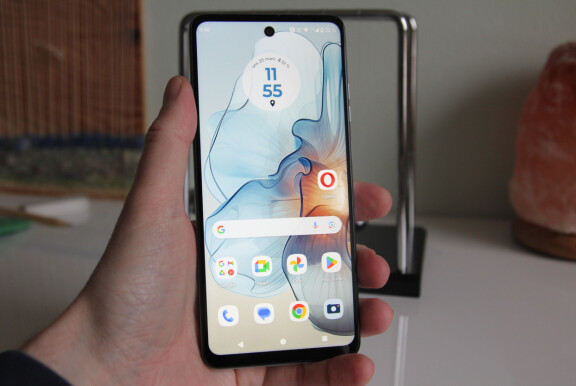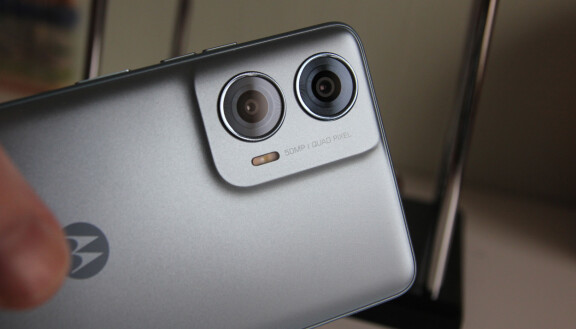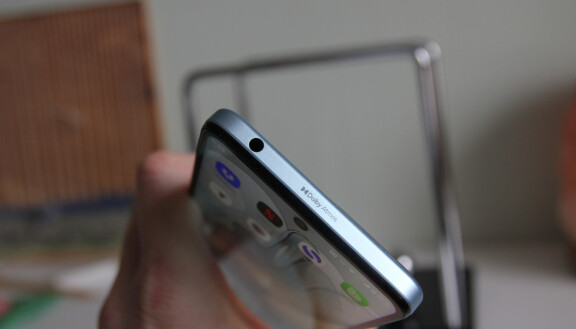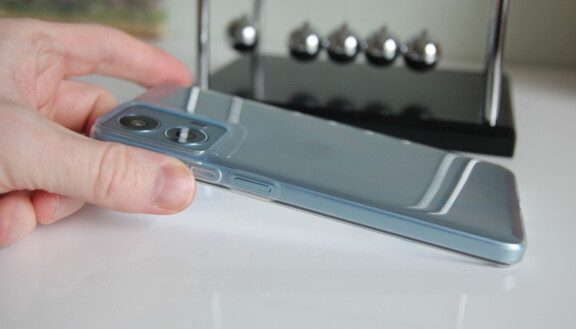Advertisement
Grade
- Telephony & Data
- 6/10
- Media & Screen
- 5/10
- Systems & programs
- 6/10
- User experience
- 6/10
- Materials & quality
- 6/10
- Total rating
- 58%
Cheap
Large battery
Generous storage memory
Speaker sound
Advertisement
Slow
The camera
The screen
For more than ten years, Motorola's Moto G series has mostly given us affordable mobile phones in the segment 2000 – 3000 kroner. The Moto G24 Power costs SEK 2,300 and as the name suggests, this is about battery life, or more specifically, an extra large battery.
The phone has a fairly simple design with a plastic back and large screen with relatively thin frames around. The phone is a bit thicker and heavier than you might expect, to accommodate the battery.
The emperor's New Clothes
When I read the specifications of the phone, I seriously start to wonder if this isn't an old phone that they put a new bigger battery on and gave it a new name. So much in the specifications feels old. But in any case, I can't find any older mobile that matches the Moto G24 Power.
This thing with old specifications is something that is noticeable in practice as soon as I turn on the phone. The screen is of the LCD type and shifts quite a lot when you hold it at different angles. It does not have full HD resolution. It does have a 90 Hz refresh rate, but the liquid crystals in the screen are so slow that it is not noticeable. The screen is also dim, but still manages decently in daylight thanks to the use of a reflective layer that allows the sunlight to help illuminate the crystals. Even cheap mobiles these days usually have a better screen than this.

The speakers, on the other hand, are surprisingly good, or it would be surprising if I hadn't gotten used to Motorola having really good stereo speakers even in their cheaper mobiles. They add depth to the sound and make it enjoyable to watch movies in speaker mode.
The chipset in the phone is a Mediatek Helio G85 which was already in the Moto G31 which was released two and a half years ago. In fact, it's been almost four years since the Mediatek Helio G85 launched, and it wasn't exactly a super-fast chipset even when it was new. By today's standards, it's snail-slow, and it happens, for example, that it takes a couple of seconds to open a note in Google Keep, after the app has already loaded. The fact that the chipset is old is also noticeable by the fact that neither the latest nor the next-to-latest Wi-Fi and Bluetooth standards are supported. This does not mean that you will have problems connecting, but you will not have access to higher speeds or other finesse that have been added since Wifi 5 and Bluetooth 5.0. This also applies to the mobile connection. 5G is missing.

Generous in one area
If I have just opened the note, it goes faster, because then it is cached in memory. In any case, you are not stingy here, 8 gigabytes of working memory and 256 gigabytes of storage are generous for the price, and should the storage still run out, there is room for memory cards.
You can guess that the level of ambition for the cameras is low when there are two cameras on the back and one is a two-megapixel macro camera. There is thus neither zoom nor wide angle, and the macro camera itself is so low-resolution that the images from them have clearly limited value.

However, the whole thing turns out to be even worse than I first thought. The main camera is indeed 50 megapixels, which is sampled down to 12.5 megapixels, but even in that resolution the images are not really sharp, but instead slightly blurry. Using the extra pixels for better digital zoom is out of the question, and you can also forget about dark photography. Even in the best case, the colors in the cameos become gloomy and brownish.
Not extreme
It can be okay with a mobile phone that is good at a single thing if it has an extra long battery life, but at the same time you should not exaggerate this. The battery is 6000 mAh, which is 20 percent more than other mobile phones in the same price range usually have. This is partly offset by the fact that LCD screens draw more power and that older circuits are less power efficient. In our screen time test, where we turn up the brightness to maximum and play a YouTube video until the phone dies, we get exactly the same battery life as the Samsung Galaxy S24, which has a significantly smaller battery.

Screen time is not the only possible measure of battery life, and when I use it in everyday life, I find that I notice the large battery more clearly. When this is written, it has been 4.5 days since I last charged the mobile phone and the battery indicator shows 44 percent. Then I haven't used it very much on two holidays, but pushed it a little more on weekdays. With slightly less frequent use and good mobile coverage, the battery should easily last a week between charges.
The system in the phone is Android 14, and the phone is promised an update to Android 15 as well as three years of security updates. The interface is pretty much what Google delivers, completely devoid of finesse and not even functions like tilting the phone to wake up the camera or the flashlight that we usually find in the Moto G series are here.
So you have to give up almost everything else to get the extra-large battery in the Moto G24 Power, but at the same time the phone is cheap, and all the apps I test work, even if they sometimes run a little slowly. Could that possibly be enough?

Questions and answers
Does the phone have a fingerprint reader? Yes, it is in the on/off button on the side and has a fast response.
Can you make payments with your mobile phone? Yes, it works fine, the phone has NFC and Google Wallet for payments.
Does it take a long time to charge the mobile phone's extra large battery? Not so dangerous. With the included 33-watt charger, it takes just under half an hour to charge the battery to half and an hour and a quarter to fully charge it.
An alternative
If it's extra battery life you're looking for, the Sony Xperia 10 V excels in that area. It is almost twice as expensive a mobile but you also get a much better screen and camera.
Camera example

It rarely gets better than this
Grade
- Telephony & Data
- 6/10
- Media & Screen
- 5/10
- Systems & programs
- 6/10
- User experience
- 6/10
- Materials & quality
- 6/10
- Total rating
- 58%
Facts
Generally
Model Moto G24 Power
Manufacturer Motorola
Launch date 2024-02-15
Measure 163.5 x 74.5 x 9 mm
Weight 197 g, 96%
Back material Plastic
Award SEK 2,300
System Android
System version 14
Promised system updates 1 system update, 3 years of security updates
The chipset Mediatek Helio G85
Manufacturing process 12 nm, 243%
Screen
Measure 6.56 inches, 99%
Resolution 1612 x 720 pixels
Screen format 20:9
Pixel density 269 ppi, 63%
Type LCD – IPS
Maximum brightness 537 nits, 30%
Image refresh rate 90 Hz, 75%
Memory
RAM memory 8GB, 87%
Storage memory 256 GB
Memory card slot Yes
Battery
Capacity 6000 mAh, 121%
Measured video time 13 hours, 8 minutes
Wireless charging No
Included charger No
Effect on the supplied charger 33 W, 49%
Maximum fast charging 30W, 59%
Web
GSM band 850 MHz, 900 MHz, 1800 MHz, 1900 MHz
3g band 850 MHz, 900 MHz, 1900 MHz, 2100 MHz
4g band Band 1 (2100 MHz), Band 3 (1800 MHz), Band 7 (2600 MHz), Band 8 (900 MHz), Band 20 (800 MHz), Band 28 (700 MHz), Band 38 (2600 MHz TDD)
5g band Don't have 5g
Dual SIM card slots Yes
Support for e.g No
Support for Wifi calls Yes
Camera
Resolution 50 Megapixel, 2 Megapixel
Wide angle lens No
Optical zoom No
Optical image stabilization No
Max resolution, video recording HD 1080p
Front camera resolution 8 megapixels
Connections
Connection plug USB Type C
Headphone jack Yes
Included headset adapter No
Bluetooth 5.0
WiFi 802.11 a/b/g/n/ac
Miscellaneous
Uncomplaining No
FM radio Yes
NFC Yes
Stereo speakers Yes
Fingerprint reader In the Power button
Benchmark tests
Antutu 10 271198, 25%
Geekbench 6: Single-core 407, 28%
Geekbench 6: Multi-core 1370, 34%
Geekbench 6: GPU 571, 8%
GFXBench Aztec Ruins Volcano High 9.3 FPS, 20%
GFXBench Manhattan ES 3.0 Wed. 41 FPS, 49%
3DMark Wild Life Stress Best 733, 10%
3DMark Wild Life Stress Lowest 728, 14%
Google Octane 13920, 39%
Jetstream 2 52,578, 48%
Cheap
Large battery
Generous storage memory
Speaker sound
Slow
The camera
The screen
